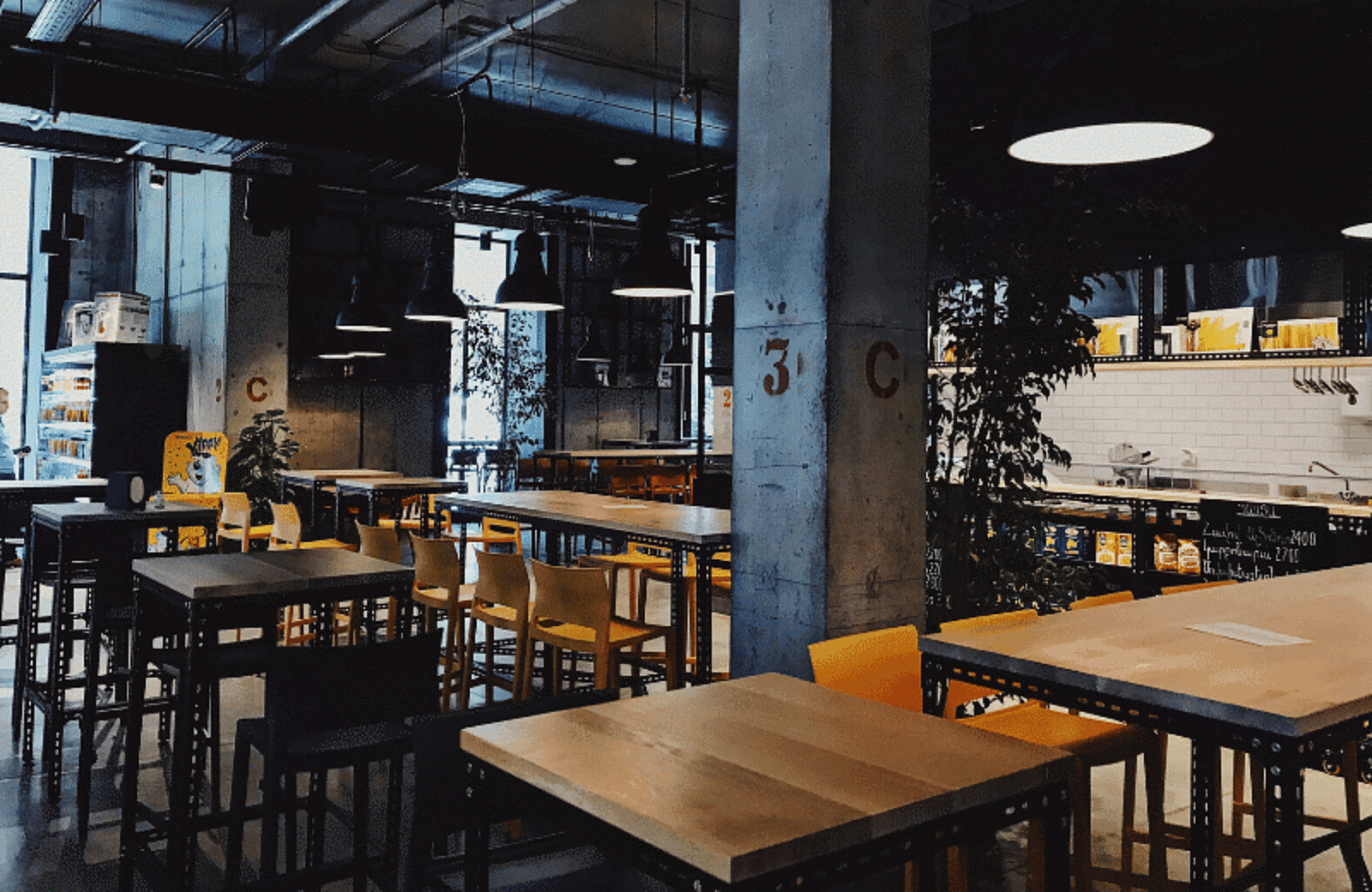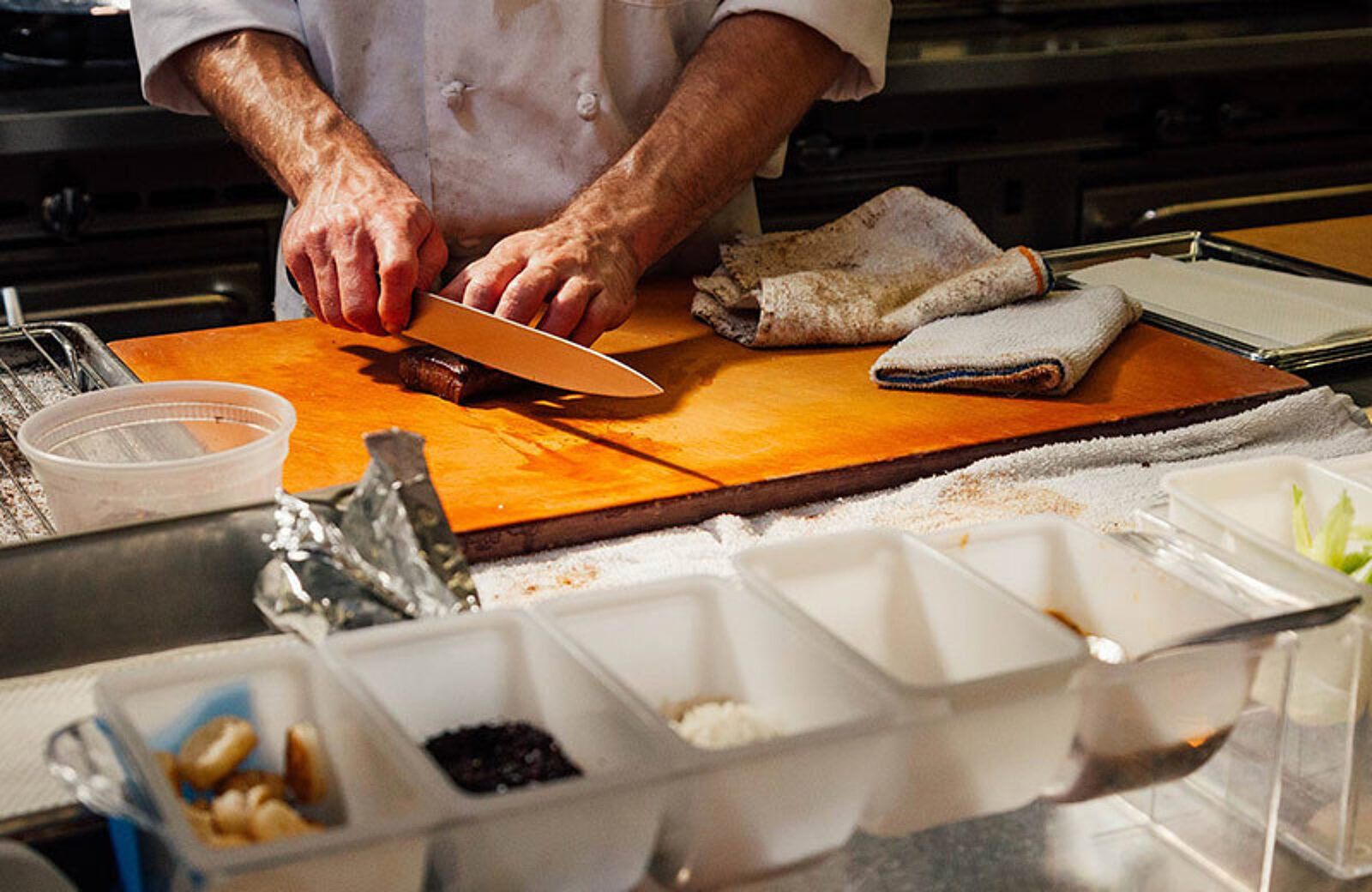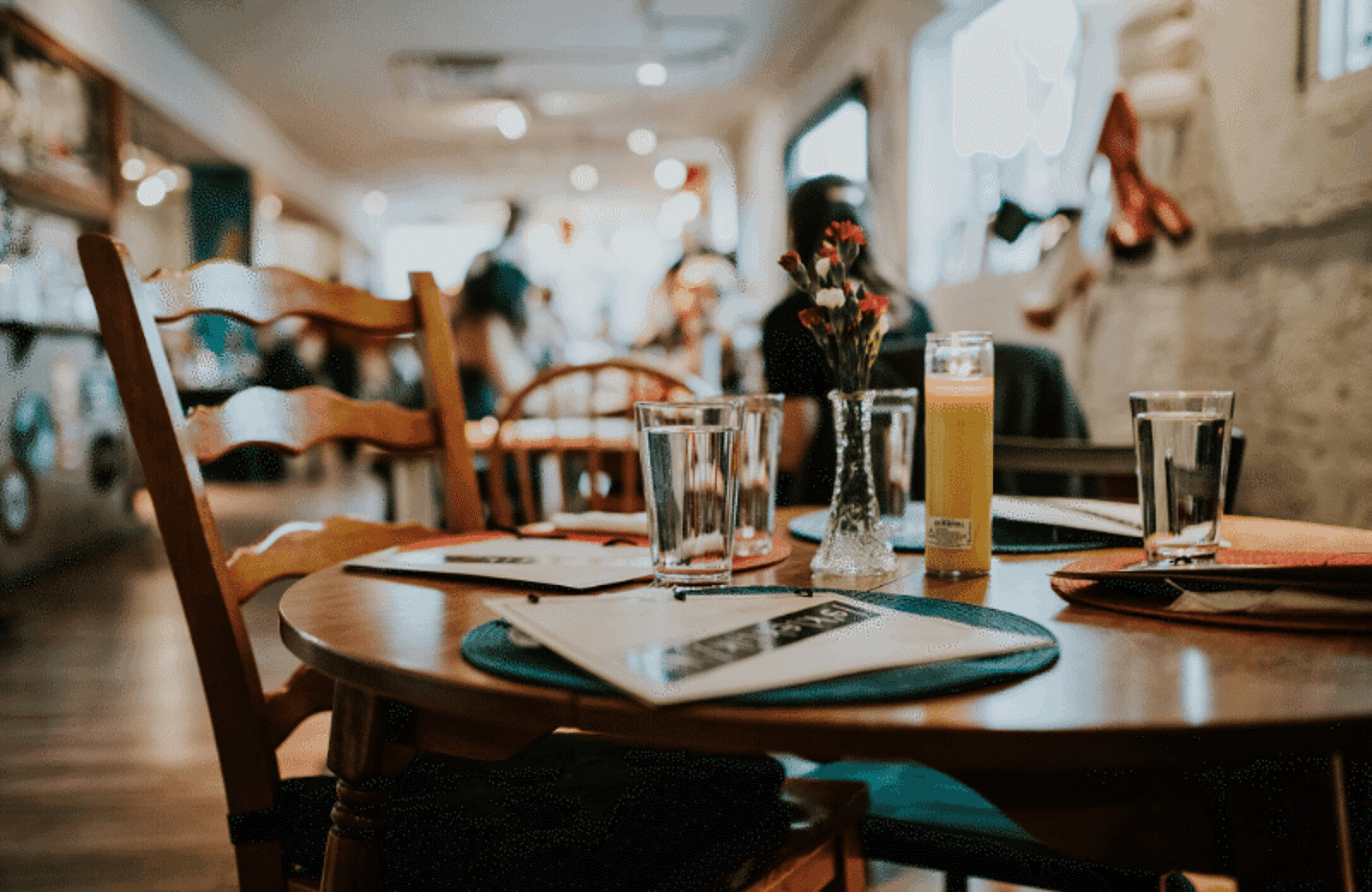Real Restaurant Kitchen Designs to Inspire Your New Concept

Allie Van DuyneAuthor
Featured image shows the Trillium Brewing Company's Fort Point location.
Whether you’re opening a restaurant, opening a second restaurant, or renovating an existing restaurant, an efficient restaurant kitchen design should be high on your list of priorities.
The kitchen is where the heart and soul of your restaurant is: the food, and the staff that create it.
Commercial kitchens with layouts that are elegant, including all of the restaurant equipment that chefs need exactly where they need them, are essential to a restaurant’s success.
Plus, technology such as kitchen display systems that help kitchen workflows rather than hinder them can improve efficiency tenfold.
Of course, there is a lot to consider when designing a restaurant kitchen. Let’s dive in to learn where to start, what to consider, and which restaurants are setting a great example with their innovative restaurant kitchen layouts.
Restaurant Floor Plan Templates
Use these restaurant floor plan templates to get inspired as you map, or reimagine, the layout and space setup for your restaurant.

Where to Start When Designing a Commercial Kitchen
There are many requirements in a restaurant kitchen, so before you dive into the factors to consider when planning a commercial kitchen design, you'll need to do a little research.
Step 1: Involve Your Chef
It’s absolutely imperative that your chef is involved in the design process.
According to chef Jet Tila in an interview with The Kraemer Edge, “no input from chefs usually means a few things: First, the wrong equipment for the restaurant. Second, the ratio of kitchen to the front of the house is off. And that usually means not enough space in the kitchen. Third, the flow is totally wrong.”
Your chef knows your menu better than you do, and they know the kind of space that the back-of-house team needs to be efficient. While you may want to get designers and front-of-house teams involved, the most important input you can gather is from the chef.
Step 2: Know Your Menu
You can’t have a kitchen without a menu, so menu development should be at the crux of your planning process.
Make a list of all of the meals on your menu and all of the specific ingredients involved in each meal. Then, write down the steps to make each menu item, including which equipment needs to be used when. This information can help you decide where to place your ovens, prep stations, etc.
Step 3: Think About What You Don’t Need
Kitchens can get cluttered, fast.
Think about how you can make each piece of equipment in the kitchen work double-time. Can an immersion blender be used to make soup as well as salsa? Would it be best to use that instead of a standing blender?
Include detailed measurements of equipment for food prep, display, refrigeration, and storage, and be ruthless when deciding what’s important. Will you have a walk-in or free-standing cold storage equipment? You can’t have both.
Step 4: Research Local Health Codes
Restaurant regulations vary state to state and are absolutely crucial to consider when designing a commercial kitchen. Health codes, fire codes, employee safety protocols, and more must be met.
Regulations may govern the distance between a food prep station and any sinks or disposal drains, the installation of vents and grease traps, the size and temperature capacity of hot water tanks, and the design and location of food storage areas.
Review all restaurant licenses and permits involved in designing a commercial kitchen, especially in your state. Here’s a comprehensive list of state food service codes and regulations by state to start.
10 Factors to Consider in Your Restaurant Kitchen Floor Plan
OK, you’re now ready to hunker down with your designers and outline your restaurant kitchen floor plan.
There are many factors to consider. No two restaurant kitchens are the same, especially between different restaurant types - full service, quick service, etc. However, there are certain factors that any back of house design should consider.
Here are the top ten:
- Flexibility & Space Efficiency
- Simplicity
- Kitchen Workflow
- Food Sanitation & Food Safety
- Supervision & Training
- Energy Efficiency
- Air Ventilation
- Maintenance
- Commercial Kitchen Equipment
- Technology that restaurant point of sale in the front of house
1. Flexibility & Space Efficiency
The kitchen should be as flexible as your menu is. Does your restaurant have daily specials? Do you change your menu every season with menu engineering data by your side? Having a kitchen that is modular - with equipment on wheels, or workstations that can be used for multiple tasks - will help you use the space more efficiently.
2. Simplicity
How can you make your kitchen simple enough that a monkey could make your meals?
OK, maybe that would fly in the face of all of the health codes we mentioned earlier, but the idea still stands: Your kitchen shouldn’t be confusing to navigate.
Save space (and money) by only using the equipment you need, and think about where you’re placing certain stations to make the kitchen workflow - from expo to line cook to executive chef - easy.
3. Kitchen Workflow
Most kitchens are chaotic. It’s the nature of a kitchen; it’s the rush of being a chef. Chris Hill talks about this rush in The Garnish podcast. However, the best kitchens use this chaos to their advantage.
WebstaurantStore recommends designing your kitchen with areas by function: cleaning, storage and inventory, food preparation, meal cooking, and service. In this layout, the waste disposal and cleaning area is far away from the meal cooking area, and completed meals exit the kitchen on one side while dirty dishes enter the kitchen on another
4. Food Sanitation & Food Safety
According to Aristair, having insufficient wash stations is one of the biggest mistakes you can make when designing a restaurant kitchen. "When planning the size of drain boards, racks and landing tables, take into account the volume of cutlery, dishes, glasses and trays that will accumulate throughout your busiest day, as well as capacity of dishwashers."
Every area of the kitchen should emphasize restaurant food safety and restaurant health codes. While the fun part of designing a kitchen may be the cooking and prep areas, the cleaning stations are just as important. Think through where your dirty dishes will pile up, as well as where to place clean dishes so they're easy to reach when plating food.
5. Supervision & Training
There should be space in the back of house for the executive chef to supervise (and train) line cooks, sous chefs, and other back of house employees. Hiring (and retaining) good restaurant staff is the #1 issue for over 50% of restaurateurs surveyed in the 2019 Restaurant Success Report, so creating an incentive program for promotion in the back of the house is extremely important. The kitchen design should leave walking room for the executive chef to supervise everything that is going on.
6. Energy Efficiency
Commercial kitchens require a lot of power. In fact, a high percentage of your restaurant budget could be devoted to energy costs. Foodservice Equpment & Supplies recommends "strategically placing cooking equipment so that the exhaust hood can whisk away hot air keeps the kitchen cooler, and putting cold storage as far as possible from heat sources to keep appliances from working overtime."
7. Air Ventilation
In the same vein of energy efficiency, it's important to consider air ventilation. Indoor air quality - odors and air circulation - will suffer if there isn't proper ventilation in the kitchen. Turn the range fan on when your chefs start cooking, not midway through, and change the filter in the range hood frequently. You may also want to plan your restaurant kitchen floor plan to include fans or air purifiers throughout the kitchen, as the back of house can become quite hot.
8. Maintenance
The number one mistake you can make when designing a commercial kitchen? Not making space for maintenance. Imagine that, three months after opening, your oven breaks down. If it's impossible for the repairman to assess the damage because other equipment or counters are too close to the oven, then you may need to buy another. That's probably not in your budget!
Plan for the worst by designing your kitchen to be modular, so you can move certain areas around to access the equipment that might break down - refrigerators, walk-ins, ranges, etc.
9. Commercial Kitchen Equipment
Here's a general list of all the restaurant equipment you might need, whether owned or leased, for your restaurant kitchen. Again, this depends on exactly what is on your menu.
- Range
- Oven
- Grill
- Deep-fryer
- Reach-in cooler or walk-in cooler
- Freezer (upright or walk-in)
- Sauté pans, sauce pans, baking pans
- Stock/soup pots
- Baking sheets
- Pizza screens, pizza paddles
- Tongs, spatulas, ladles
- Chef’s knives
- Mixing bowls, serving bowls
- Steam table
- Entree, appetizer, and dessert plates
- Cleaning rags, cleaning buckets
- Rubber floor mats
- Hand soap/sanitizer dispenser
- Fire extinguisher
10. Technology
The technology in your back of house should also be modular, flexible, and easy to use. Many restaurants operate with paper tickets, or chits, posted to the kitchen. However, kitchen display screens can maximize accuracy and increase the amount of tickets your kitchen is able to serve with custom routing preferences to prep stations, ticket and fulfillment time reports, and integrations with online ordering systems.
According to Will Goodwin of Spoken Cafe, "Toast KDS screens tell us exactly how long it’s taking to get an order to the customer, because each order has a timer on it. We have a better grasp on how we’re managing the line in that moment."

7 Examples of Restaurant Kitchen Layouts
As I mentioned earlier, every restaurant kitchen is different, and different restaurant concepts will require different designs. Here are a few examples of restaurants across different segments that have efficient kitchens.
1. The Island at the Center
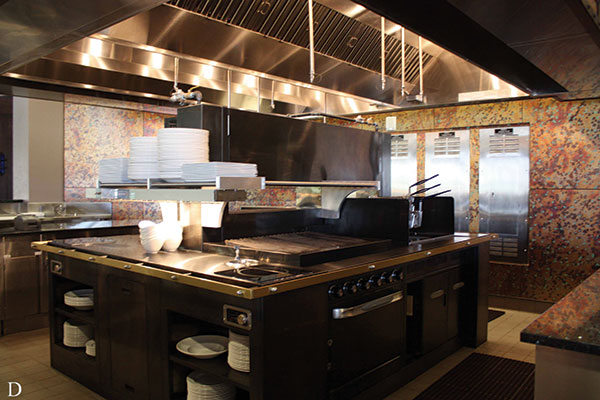
Deep Blu Seafood Grille in Orlando, FL via Restaurant Development + Design by Emily Galvin
With an island at the center of the kitchen, chefs congregate in the same area and handoffs from sous chef to cook to expo are smooth. This design also helps executive chefs supervise the entire menu creation process, as they can easily walk around the island.
2. Zoning Regulations in the Kitchen
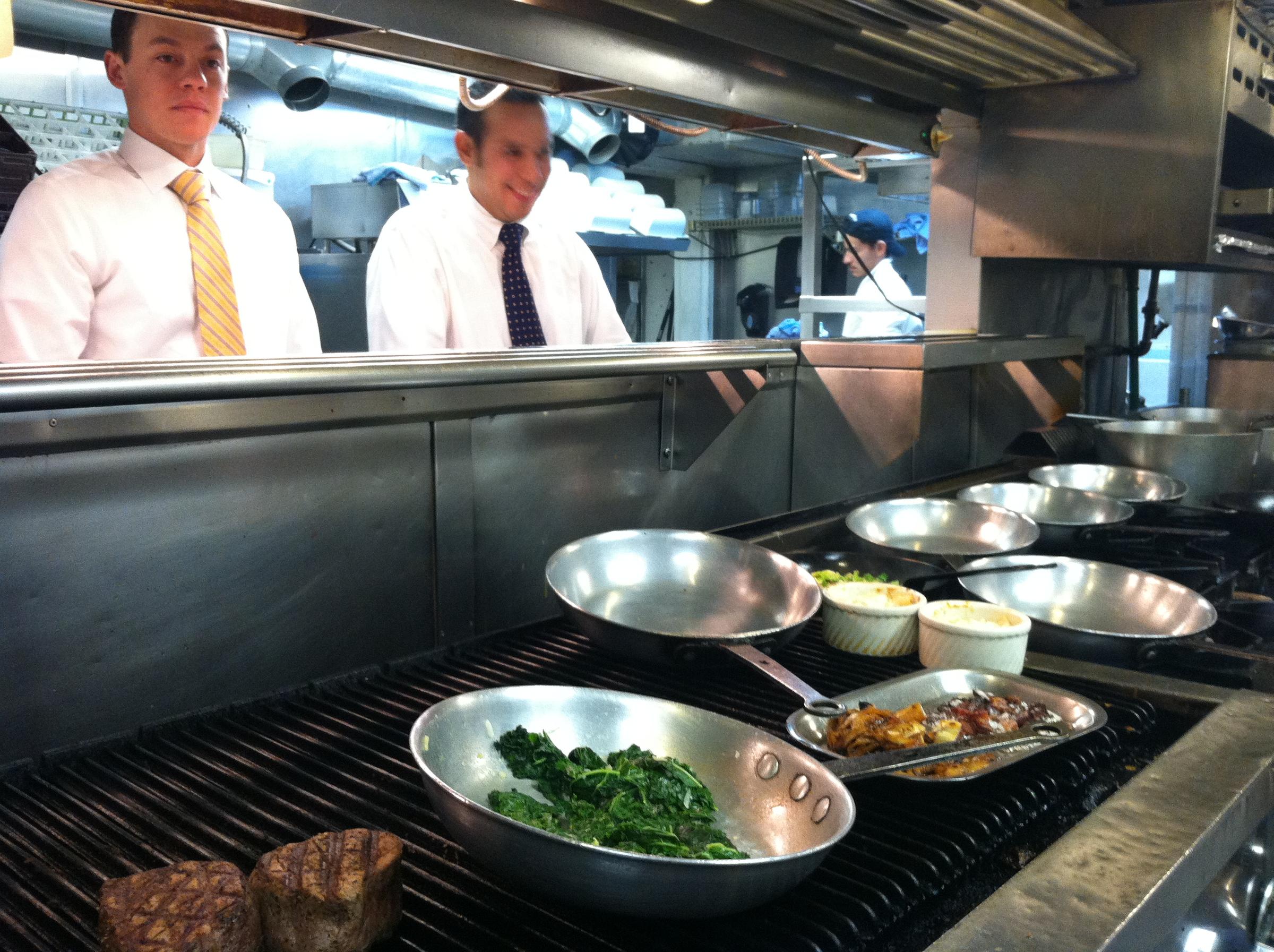
Cache Cache in Aspen, CO via Aspen Public Radio by Marci Krivonen
All restaurants have kitchens with different areas for different tasks, or zones. Servers are responsible for expoing their own food, and many courses need to be made across a variety of different stations. These designs might require multiple KDS systems for each prep or cook station, or routing based on service area (outside seating vs. inside seating, east vs. west dining room).
3. The Assembly Line Layout
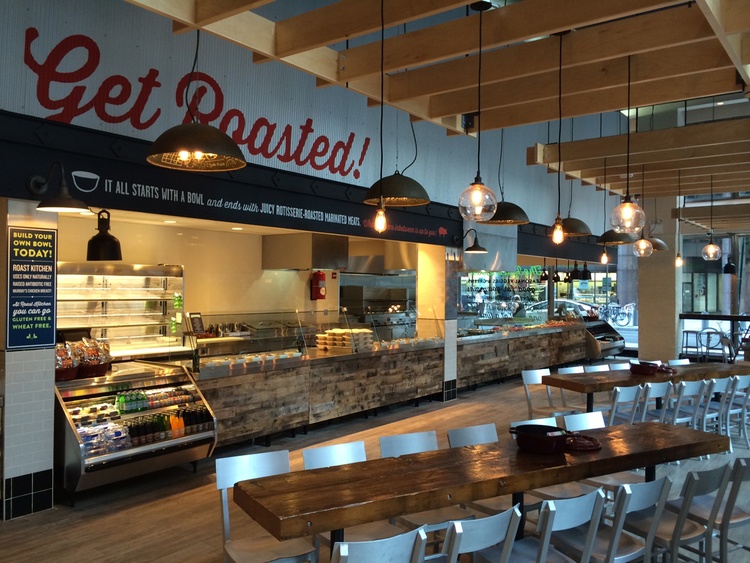
Roast Kitchen in New York City, NY via American Design Language
Popular among quick service and fast casual restaurants like Saloniki and Chipotle, the assembly line layout allows customers to customize their meal as they go. The assembly line layout often has an area off to the side for the "back of house" to prep while "front of house" employees serve. They often require employees to pay at the end of the line on a customer-facing POS tablet, and have many online orders that also need to be fulfilled.
4. The Restaurant Kitchen Layout That Glorifies Prep
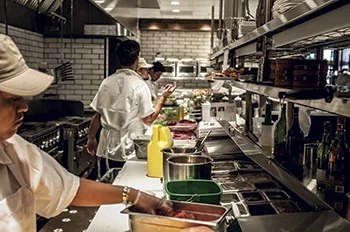
Barcelona Wine Bar in Norwalk, CT via FE&S Magazine
Similar to the assembly line layout, but for full service and fine dining restaurants, prep-line style kitchens emphasize the importance of food preparation. At Barcelona Wine Bar, owner Andy Pforzheimer has many different prep stations for different meals.
"All dishes are cooked to order," he said in an interview with FE&S Magazine. "We used to use sauté pans more, but we’ve moved away from that and gone with traditional Spanish planchas. Not only is this more authentic, but there are fewer pans to clean. In addition to the 18- to 24-burner plancha, the cooking battery includes fryers, a 6-burner stove and charbroiler. Our kitchens also include a cold tapas station that puts out food separately. We do a large amount of meat and cheese platters, which are prepared with antique slicers. Separate prep areas include mixers for preparing empanadas from scratch."
5. The Ergonomic Kitchen Configuration

Surly Brewing Co. in Minneapolis, MN via Restaurant Development + Design by Corey Gaffer Photography
While you need to consider the flow of inventory to the kitchen, you also need to consider the flow of employees throughout the kitchen. An ergonomic kitchen configuration features separate work and traffic aisles, minimizing accidents.
6. The Open Restaurant Kitchen
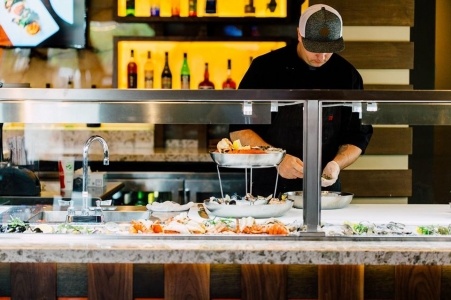
B-Town Kitchen and Raw Bar in Bellingham, WA via Cascadia Weekly
Popular among fine dining restaurants, the open kitchen design allows restaurant diners to watch the chefs as they prepare their meals. The design often features a glass partition as well as serving stations facing the dining area. There are pros and cons to this approach: it could motivate your chefs to create higher quality food, or it could expose your diners to the heat (and chaos) of the kitchen.
7. Bonus: Food Truck Kitchen Design
.jpg)
Lombardi Pizza Co. in Edison, NJ via SeriousEats by Adam Kuban
You might not think of food truck design when you think of commercial kitchens, but the truth is, all of the above factors are magnified tenfold in a small 10' by 30' food truck. Having a food truck kitchen designed around workflow - such as the above, with stations for pizza preparing, pizza cooking, and pizza plating - will help your food truck serve more customers.
Your Turn: How Is Your Restaurant Kitchen Designed?
Who knows the most about efficient restaurant kitchen designs? The chefs and restaurateurs that spend every day (from early morning prepping) and every night (to late-night guests) in the back of house.
We want to hear your thoughts on effective restaurant kitchen designs.
Comment below, and don't forget to check out our food cost calculator to help your back-of-house menu initiatives!
Related Restaurant Design Resources
Is this article helpful?
DISCLAIMER: This information is provided for general informational purposes only, and publication does not constitute an endorsement. Toast does not warrant the accuracy or completeness of any information, text, graphics, links, or other items contained within this content. Toast does not guarantee you will achieve any specific results if you follow any advice herein. It may be advisable for you to consult with a professional such as a lawyer, accountant, or business advisor for advice specific to your situation.
